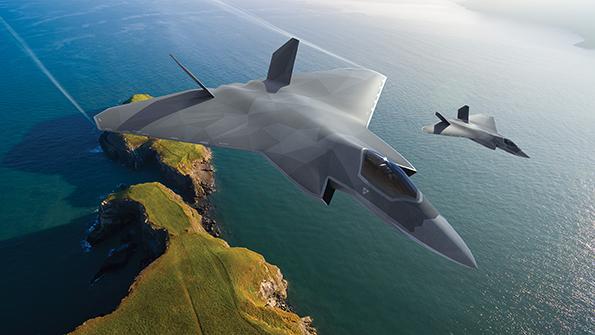This article is published in Aviation Week & Space Technology and is free to read until Aug 30, 2024. If you want to read more articles from this publication, please click the link to subscribe.

A new GCAP fighter configuration with an enlarged trapezoidal delta wing was displayed at Farnborough.
Despite an impending UK defense review, the industrial partners in the trinational Global Combat Air Program are not holding back their development efforts.
Media headlines in the run-up to the Farnborough International Airshow had muddied the waters. Reporting had suggested that UK involvement in the three-nation bid with Italy and Japan to produce a new-generation combat aircraft could be cut in favor of more immediate priorities, with interservice rivalries seemingly bubbling to the surface.
- Industrial partners finalizing approach to workshare and joint ventures
- New aircraft features enlarged delta wing
- UK fighter demonstrator in assembly ahead of 2027 first flight
And while nothing can be taken for granted in the “root and branch review” of defense ordered by new Prime Minister Keir Starmer in mid-July, UK industry leaders were buoyed by an apparent “show of force” by new Labour government ministers eager to examine a full-scale model of the Global Combat Air Program (GCAP) fighter virtually draped in the Union Jack in one of the show’s exhibit halls.
By this time next year, industry expects to have received full-scale multi-year development contracts from London, Rome and Tokyo to deliver the next-generation crewed combat aircraft in 2035, replacing Italian and UK Eurofighter Typhoons as well as Japan’s Mitsubishi F-2s.
“The pace continues to go [forward],” Herman Claesen, BAE Systems managing director for Future Combat Air Systems, told a packed GCAP news conference on the first day of the air show. “Of course, we need to respect the fact that the government has called an SDR [Strategic Defense Review] . . . and wants to look out at the priorities and everything that goes with it.”
- Related Content: Boeing 757 Trials Platform Will Put GCAP Technology In The Sky
Even if the SDR were not taking place, Claesen noted, the industrial partners would still need to provide supporting information for business case reviews.
Officials close to the program say the ministerial interest during Farnborough appears to have helped calm international concerns that the new UK government could take a change in tack.
“All the messaging we’ve received is that the GCAP ambitions are completely consistent with those of the new government’s manifesto and aspirations for the UK economy, for the creation and protection of jobs and sovereign capability, and for the type of international partnerships that GCAP represents,” Andrew Howard, director of Future Combat Air at Leonardo UK, said at Farnborough.
Despite the distraction of the review, industry is eager to maintain the rapid pace of the project necessary to meet the tight 2035 deadline for service entry demanded by the three nations, particularly Japan. Industrial partners in the program have been tasked with determining workshare so as to avoid the fixed, politically delineated workshares of previous collaborative projects such as the Eurofighter and Panavia Tornado. This process is now close to being finalized, Claesen said.
Progress is also underway on establishment of an industrial joint venture among BAE Systems, Leonardo and Mitsubishi Heavy Industries that must be done ahead of the development contract. The joint venture is being designed to be “more efficient, faster and more suitable for international cooperation from [other] foreign countries [outside the existing program],” Leonardo Chief GCAP Officer Guglielmo Maviglia said, noting that the three partner countries do not wish to dismantle the work already done.
Such a construct could benefit countries that have shown interest in joining GCAP, such as Saudi Arabia, which sees entry into the program as a steppingstone in building up its manufacturing capabilities and reducing its economy’s dependence on oil. Riyadh’s accession could also bring valuable additional funding and perhaps a long-awaited Eurofighter order that could bridge production gaps. However, Saudi Arabia’s membership in the initiative would need the backing of all three GCAP partner nations.
London, Rome and Tokyo agreed in late 2023 on a treaty to form the GCAP International Government Organization (GIGO), a UK-based entity with rotational management that will operate like the U.S. F-35 Joint Program Office. GIGO will award contracts for the different phases, define and prioritize requirements and resolve issues between the partners. The treaty still needs to be ratified by the three nations.
Beyond the politics, a new configuration of the GCAP fighter was unveiled at Farnborough as the industry partners moved to finalize the aircraft’s outer mold line. The lambda-wing configuration of previous models has been replaced by an enlarged trapezoidal delta wing, with the trailing edge extending behind the engine nozzles.
Officials remain tight-lipped about the aircraft’s weight and size, but Aviation Week estimates the aircraft to be slightly larger than a Lockheed Martin F-22 and at least a third larger than the Eurofighter Typhoon. Notably, the mockup suggests a broad, deep and voluminous fuselage for internal weapons carriage and fuel.
Running in parallel with the GCAP development efforts are UK plans to fly a technology demonstrator aircraft within three years. The Tempest crewed combat air demonstrator is now in an advanced state of assembly, following a critical design review in May. Half the weight of the aircraft is in manufacture or assembly, with work on the front, center and rear fuselage sections and wings now well underway, BAE Systems officials say. The company is using hot isostatic pressing to produce primary structural components. It is an additive process in which powdered titanium is forced together under heat and pressure. The approach reduces material waste and can shorten lead times to months rather than years. Engineers have designed certain components exclusively for additive manufacturing, Paul Wilde, head of Tempest at BAE Systems, told reporters.
The Tempest demonstrator is likely to be slightly smaller than the final GCAP fighter, limited in size and mass by the performance of its two off-the-shelf Eurojet EJ200 engines. Officials have also confirmed that the demonstrator will be fitted with at least one “integrated payload bay,” or weapon bay, that will release munitions. This will help to rebuild that competence in the UK, where the last tactical combat aircraft built with a weapon bay was the Blackburn Buccaneer that first flew in 1958.
Test pilots from BAE Systems, Rolls-Royce and the Royal Air Force have flown about 215 hr. on the demonstrator’s simulator. The aircraft is expected to be the first flying platform to make use of the Pyramid avionics design architecture developed by BAE Systems and the UK Defense Ministry.
At the heart of the demonstrator effort is a push to rebuild national skills and capabilities, especially as the UK has not developed or built a clean-sheet military aircraft alone for several decades.
“This is not just about building a new aircraft,” Wilde said, “but testing and commissioning and proving all those systems in order to generate the evidence required for airworthiness authorities. That’s a really important part of the next step ahead of us.”
“We hope this demonstrator will bring a whole generation of new engineers and other folk in aerospace into this sector to support the long-term program and realize the much wider benefits in the wider economy and in the long term,” said Air Cdre. Martin Lowe, Future Combat Air Systems program director at the UK Defense Ministry.





